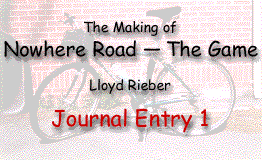

I've decided that the game will have 3 goals. The first goal is simply that the game ought to be fun for both kids and grown-ups. The second goal is highlight the beauty and eccentricity of the real Nowhere Road as it winds through Madison, Jackson, and Clarke Counties in Northeast Georgia. I wanted the game to authentically replicate my daily bike ride to and from work. Third, the game is to teach about bicycle safety, but in a way that does not interfere with the fun elements of the game. I see this as an instructional design opportunity rather than a design problem.
I consider the "acid test" of the game's final design to be whether a fifth or sixth grader would actually want to play and then continue to play the game. Of course, saying that the game teaches bicycle safety immediately sends a strong boring signal to 10- and 40- and 60-something year olds along the lines of "beware, the following software package may actually teach you something". (Parent to child: "If you don't behave, Santa will only bring you educational toys.") After all, we all know that it can't be good for you and taste good at the same time. (That's almost as un-American as suggesting one ought to exercise and eat less to lose weight!) So, my thinking is to keep the focus on Nowhere Road and use its eccentricity and the interactivity of a bicycle ride to keep the player entertained and challenged. Bicycle safety will be interjected along the way. I also see other wonderful learning opportunities, such as geography (map reading, map projection) and stuff that I haven't thought of yet.
Designing the interface
I like to start building a prototype as soon as possible and I have found Authorware to be a great tool for this. So, I began this game by playing around with an idea of how to mimic the experience of pedaling a bicycle: pressing two keys in rapid succession. It turned out to be very easy to do with Authorware. Within about 20 minutes I had built a simple interface where a small red dot moved along a (hastily) constructed "bird's eye view" of Nowhere Road. The dot moved only while 'pedaling'.
I wanted to reinforce the illusion that the player was pedaling a bicycle while pressing the two keys in succession. I have a children's animation program called "Amazing Animation" that includes a variety of clip animations, including an 8-frame sequence of a biker pedaling away. I was able to import this animation into Authorware (with a little ingenuity) and tied the pedaling action (via the keyboard) to the animation. I think it creates an effective interface. The only downside is that it depicts a "white male" as the biker. Ideally, I would eventually like the player to be able to choose a graphic that comes closer to including their own cultural group. Of course, the guy in this clip animation seems to have orange hair, a small nose, and is a little too fit, so he doesn't quite capture either my Polish-German-Slovak (i.e. American mutt), accordion-playing, love-the-Pirates-hate-the-Yankees, eat-like-there's-no-tomorrow cultural group.
Unfortunately, after playing this prototype for a little while, I found my two fingers getting tired! I decided to build an alternative input strategy of just pressing the left mouse button rapidly. This was a little tricky because at first the bicycle pedaled itself when you just held the mouse button down! (I guess this would be OK as a throttle for a motorcycle -- I'll keep this in mind for other games.)
Finally, I stumbled across one of those "Whowhere" web sites where you can get a map for any street address in the world. Yep, my street address on Nowhere Road was there. I copied and pasted this map for use in my game. This was an important step because the animation path taken by the red dot must be manually constructed. It's a pain to redo this. I'm comfortable with the look and feel of this map.
Back-Burner Design Ideas
Technical Problems & Solutions
Post Script
My first prototype represents about two hours of work. Interestingly, I have spent far more time documenting my design than on programming the game!